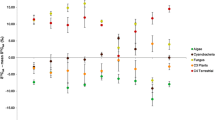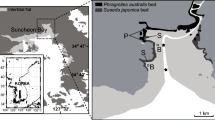Summary
Stable carbon and nitrogen isotope ratios in autotrophs, aquatic invertebrates and fishes from the Orinoco River floodplain of Venezuela reveal that microalgae, including both phytoplankton and epiphytic (attached) forms, are predominant energy sources for many aquatic animals, even though aquatic vascular plants are much more abundant. Floating mats of the grass Paspalum repens and the water hyacinth Eichhornia spp. harbor particularly high densities of aquatic animals, but isotopic evidence indicates that few species are dependent on organic carbon originating from these plants. The stable isotopic evidence for the trophic importance of algae contradicts traditional interpretations of food webs in freshwater wetlands, which are generally thought to be based largely on detritus originating from vascular plants.
Similar content being viewed by others
References
Araújo-Lima C, Forsberg B, Victoria R, Martinelli L (1986) Energy sources for detritivorous fishes in the Amazon. Science 234:1256–1258
Bayley PB (1989) Aquatic environments in the Amazon Basin, with an analysis of carbon sources, fish production, and yield. In: Dodge DP (ed) Proc Int Large Rivers Symp, Can Spec Publ Fish Aquat Sci 106:399–408
Bayley PB, Petrere M Jr (1989) Amazon fisheries: Assessment methods, current status and management options. In: Dodge DP (ed) Proc Int Large Rivers Symp, Can Spec Publ Fish Aquat Sci 106:385–398
Benner R, Fogel ML, Sprague EK, Hodson RE (1987) Depletion of 13C in lignin and its implications for stable carbon isotope studies. Nature 329:708–710
Bowen SH (1987) Composition and nutritional value of detritus. In: Moriarty DJW, Pullin RSV (eds) Detritus and microbial ecology in aquaculture. (ICLARM Conference Proceedings 14). International Center for Living Aquatic Resources Management, Manila, Philippines, pp 192–216
De Niro MJ, Epstein S (1981) Influence of diet on the distribution of nitrogen isotopes in animals. Geochim Cosmochim Acta 45:341–351
Engle DL, Melack JM (1990) Floating meadow epiphyton: Biological and chemical features of epiphytic material in an Amazon floodplain lake. Freshwater Biol 23:479–494
Farquhar GD, Ehleringer JR, Hubick KT (1989) Carbon isotope discimination and photosynthesis. Annu Rev Plant Physiol Plant Mol Biol 40:503–537
Fry B (1988) Food web structure on Georges Bank from stable C, N, and S isotopic compositions. Limnol Oceanogr 33(5):1182–1190
Fry B, Sherr E (1984) 13C measurements as indicators of carbon flow in marine and freshwater ecosystems. Contrib Mar Sci 27:13–47
Fry B, Macko SA, Zieman JC (1987) Review of stable isotopic investigations of food webs in seagrass meadows. In: Durako MJ, Phillips RC, Lewis RR III (eds) Proc Symp Subtropical-Tropical Seagrasses of the Southeastern US, 12 Aug 1985. (Florida Marine Research Publ 42). Florida Dept Natural Resources, Bureau of Marine Research, St. Petersburg, pp 189–209
Goulding M (1980) The fishes and the forest: Explorations in Amazonian natural history. Univ Calif Press, Berkeley
Goulding M, Leal Carvalho M, Ferreira EG (1988) Rio Negro, rich life in poor water. SPB Academic Publishing, The Hague, The Netherlands
Hamilton SK, Lewis WM Jr (1987) Causes of seasonality in the chemistry of a lake on the Orinoco River floodplain, Venezuela. Limnol Oceanogr 32(6):1277–1290
Hamilton SK, Sippel SJ, Lewis WM Jr, Saunders JF III (1990) Zooplankton abundance and evidence for its reduction by macrophyte mats in two Orinoco floodplain lakes. J Plankton Res 12(2):345–363
Hedges J, Clark W, Quay P, Richey J, Devol A, Santos UM (1986) Compositions and fluxes of particulate organic material in the Amazon River. Limnol Oceanogr 31(4):717–738
Howard-Williams C, Junk WJ (1976) The decomposition of aquatic macrophytes in the floating meadows of a Central Amazonian várzea lake. Biogeographica 7:115–123
Howard-Williams C, Junk WJ (1977) The chemical composition of Central Amazonian aquatic macrophytes with special reference to their role in the ecosystem. Arch Hydrobiol 79(4):446–464
Irmler U (1975) Ecological studies of the aquatic soil invertebrates in three inundation forests of Central Amazonia. Amazoniana 5(3):337–409
Junk WJ (1973) Investigations on the ecology and production-biology of the “floating meadows” (Paspalo-Echinochloetum) on the Middle Amazon. Part. II. The aquatic fauna in the root zone of floating vegetation. Amazoniana 4(1):9–102
Junk WJ (1984) Ecology of swamps on the Middle Amazon. In: Gore AJP (ed) Mires: Swamp, bog, fen and moor. (Ecosystems of the world 4B). Elsevier, Amsterdam, pp 269–294
Junk WJ (1984) Ecology of the várzea, floodplain of Amazonian whitewater rivers. In: Sioli H (ed) The Amazon. (Monographiae Biologicae, vol 56). Dr W Junk, Dordrecht, The Netherlands, pp 215–244
Junk WJ (1985) The Amazon floodplain—A sink or source for organic carbon? Mitt Geol-Paläont Inst, Univ Hamburg, SCOPE/UNEP Sonderband 58:267–283
Kitting C, Fry B, Morgan M (1984) Detection of inconspicuous epiphytic algae supporting food webs in seagrass meadows. Oecologia 62:145–149
Klopatek JM (1988) Some thoughts on using a landscape framework to address cumulative impacts on wetland food chain support. Environ Management 12(5):703–711
Mann KH (1988) Production and use of detritus in various freshwater, estuarine, and coastal marine ecosystems. Limnol Oceanogr 33(4, pt 2):910–930
Minigawa M, Wada E (1984) Stepwise enrichment of 15N along food chains: Further evidence and the relation between δ15N and animal age. Geochim Cosmochim Acta 48:1135–1140
Murkin HR (1989) The basis for food chains in prairie wetlands. In: Van der Valk A (ed) Northern prairie wetlands. Iowa State Univ Press, Ames, pp 316–338
O'Leary MH (1981) Carbon isotope fractionation in plants. Phytochemistry 20(4):553–567
Peterson B, Fry B (1987) Stable isotopes in ecosystem studies. Annu Rev Ecol Syst 18:293–320
Peterson B, Howarth R (1987) Sulfur, carbon, and nitrogen isotopes used to trace organic matter flow in the salt-marsh estuaries of Sapelo Island, Georgia. Limnol Oceanogr 32(6):1195–1213
Petr T (1983) The Purari: Tropical environment of a high rainfall river basin. (Monographiae Biologicae, vol 51). Dr W Junk, The Hague, The Netherlands
Rodríguez MA, Lewis WM Jr (1990) Diversity and species composition of fish communities of Orinoco floodplain lakes. Natl Geogr Res 6(3):319–328
Sattler W (1967) Über die Lebensweise, insbesondere das Bauverhalten, neotropischer Eintagsfliegen-Larven (Ephemeroptera, Polymitarcidae). Beitr Neotrop Fauna 5(2):89–110
Soares MGM, Almeida RG, Junk WJ (1986) The trophic status of the fish fauna in Lago Camaleão, a macrophyte dominated floodplain lake in the middle Amazon. Amazoniana 9(4):511–526
Straskraba M (1964) Preliminary results of a new method for the quantitative sorting of freshwater net plankton into main groups. Limnol Oceanogr 9:268–270
Sullivan MJ, Moncreiff CA (1990) Edaphic algae are an important component of salt marsh food-webs: Evidence from multiple stable isotope analyses. Mar Ecol Prog Ser 62:149–159
Twombly S, Lewis WM Jr (1987) Zooplankton abundance and species composition in Laguna La Orisinera, a Venezuelan floodplain lake. Arch Hydrobiol/Suppl 79, V 1:87–107
Vásquez E (1989) The Orinoco River: A review of hydrobiological research. Regulated Rivers: Res Manag 3:381–392
Ward JV (1989) Riverine-wetland interactions. In: Sharitz RR, Gibbon JW (eds) Freshwater wetlands and wildlife. US Dept Energy, DOE Symp Ser No 61, pp 385–400
Author information
Authors and Affiliations
Rights and permissions
About this article
Cite this article
Hamilton, S.K., Lewis, W.M. & Sippel, S.J. Energy sources for aquatic animals in the Orinoco River floodplain: evidence from stable isotopes. Oecologia 89, 324–330 (1992). https://doi.org/10.1007/BF00317409
Received:
Accepted:
Issue Date:
DOI: https://doi.org/10.1007/BF00317409




